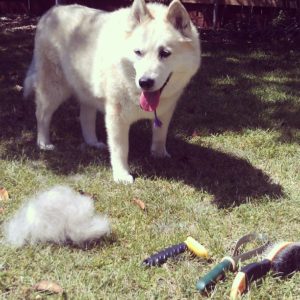Black pants work as a magnet for dog fur, and couch cushions can easily be overrun with cat hair. Even birds like parrots molt, causing them to shed old feathers and grow healthy new ones. While shedding can be a funny habit or a minor nuisance, it can also be a huge problem for allergy sufferers. Thus, it’s important to know what kinds of animals shed, how much they shed, and ways to monitor excessive shedding.
Type of Animal
 Most animals shed, including all mammals. This means that horses, rabbits, and even mice seasonally shake off their fur. Though not quite the same, reptiles like snakes and insects like spiders are also known to molt, which essentially means that they shed their skin. Even humans shed, which is why you’ll occasionally find random hair strands clogging your shower drain. It’s essential for these animals to shed and molt in order to keep their skin and fur healthy and shiny. However, the amount they shed varies based on season, nutrition, and breed.
Most animals shed, including all mammals. This means that horses, rabbits, and even mice seasonally shake off their fur. Though not quite the same, reptiles like snakes and insects like spiders are also known to molt, which essentially means that they shed their skin. Even humans shed, which is why you’ll occasionally find random hair strands clogging your shower drain. It’s essential for these animals to shed and molt in order to keep their skin and fur healthy and shiny. However, the amount they shed varies based on season, nutrition, and breed.
Season
Depending on the season, your pet is prone to shedding more or less. This is because they need different coats dependent upon the weather. For instance, during the spring, dogs shed their winter coat for a lighter, more heat-friendly summer coat. And during the fall, they’ll shed this shorter coat in order to make way for a longer and warmer winter coat. You should always be prepared for these shedding-heavy months, as you might need to brush your pet more often or take proactive measures for cleaning up excess fur from your home.
Nutrition/Diet
If your pet isn’t getting the nutrients he requires, he’s likely going to shed more. Conversely, a diet rich in protein and nutrients can prevent or almost stop shedding entirely. Similarly, if your pet is stressed or not feeling well, he’s usually going to shed more. Excessive shedding can be a sign of an underlying medical condition, like a tumor or hormonal imbalance, and it should always be investigated by a veterinarian.
Which Animals are the Worst Offenders?
 You can often tell just by looking whether a dog or cat is going to be a heavy shedder. For instance, the fluffy Bernese Mountain dog and poofy Ragdoll are both major-league shedders, as are Chow Chows and Siberian cats. However, some animals shed a surprisingly large amount, including sleek Dalmations and tiny Chihuahuas. For this reason, you should always do your research before adopting your pet and not judge by looks alone.
You can often tell just by looking whether a dog or cat is going to be a heavy shedder. For instance, the fluffy Bernese Mountain dog and poofy Ragdoll are both major-league shedders, as are Chow Chows and Siberian cats. However, some animals shed a surprisingly large amount, including sleek Dalmations and tiny Chihuahuas. For this reason, you should always do your research before adopting your pet and not judge by looks alone.
Which Animals Don’t Shed?
There are several animals that either don’t shed or shed so little that it’s basically unnoticeable. These animals are called hypoallergenic, meaning that even allergy sufferers can keep them as pets. Some hypoallergenic dogs include the Maltese, Poodle, and Italian Greyhound, while hypoallergenic cats consist of the Oriental Shorthair, Sphynx, and Russian Blue. Additionally, fish are allergen-free, and pigs have started becoming a popular house-pet, due in part to their lack of shedding.
What Else Can Cause Shedding?

Along with season, diet, and breed, there are a few factors that can contribute to shedding. Something as simple as using the wrong type of shampoo can cause your pet to lose hair, especially if you’re using your own shampoo! It’s also possible that your pet has a parasite, like a flea or a tick — this is a more serious issue, since parasites can also cause itching, discomfort, and anemia. If neither of these factors appear to be at play, it’s possible that your pet is simply stressed.
If your pet is stressed, you’ll want to find the source of that stress and fix or remove it. Said stress can be caused by a variety of things, including a new family member, new routine, or recent move. If you take action to alleviate that stress and notice no change, it might be time to see your veterinarian — some animals benefit from anti-anxiety medication, while others might be stressed because of a treatable medical issue.
Shedding is completely normal, and it helps our pets’ fur and skin stay healthy. It also allows our pets to better regulate their internal temperatures during fluctuating weather. Excessive shedding, however, can be a sign of health issues — if your pet has a tendency to shed a lot, you’ll want to bring him to your vet for a diagnosis. However, heavy shedding is just a norm for certain pets, and it can easily be managed with brushing and a good diet. Besides, it’s not your pet’s fault he sheds a lot — humans shed 100 to 200 hairs a day. Imagine if we were covered in it!
